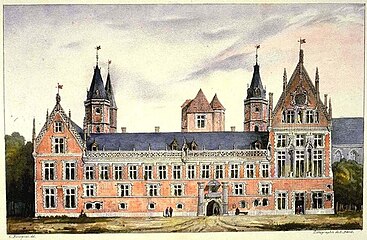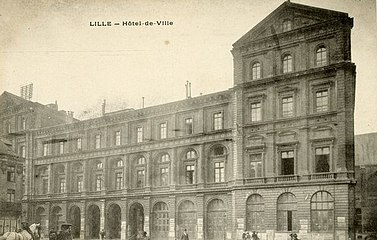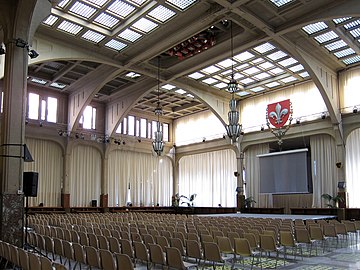Hôtel de Ville, Lille
You can help expand this article with text translated from the corresponding article in French. (February 2021) Click [show] for important translation instructions.
|
| UNESCO World Heritage Site | |
|---|---|
 Lille's Town Hall | |
| Location | Lille, France |
| Part of | Belfries of Belgium and France |
| Criteria | Cultural: (ii), (iv) |
| Reference | 943bis-008 |
| Inscription | 1999 (23rd Session) |
| Extensions | 2005 |
| Coordinates | 50°37′50″N 3°04′16″E / 50.63056°N 3.07111°E |
The Hôtel de Ville (French pronunciation:
The Town Hall is located on the Place Roger Salengro, next to the Porte de Paris, in the eastern part of the city centre. This site is served by the Mairie de Lille metro station on line 2 of the Lille Metro.
History
At the beginning of the 20th century, Lille's Town Hall was located on the Place Rihour. It had been built by the architect
The site, chosen in favour of the downgrading of the military fortifications pronounced in 1919, was located on the Square Ruault, in the working class district of Saint-Sauveur, then out of the way and particularly marked by the industrial habitat of the 19th century. Dubuisson's project provided for a complete overhaul of the district, which was dilapidated and unhealthy, and in particular the drilling of new paths of Haussmann-esque inspiration. The building site, started in 1924, continued under the mandate of Roger Salengro, mayor of Lille from 1925, who decided to add a belfry. The construction of the belfry, the first reinforced concrete building over 100 meters high in France, was built in two stages, from 1929 to 1931. It ended in 1932 with its inauguration.
Nonetheless, the initial project formed by Dubuisson was only partially realised. The war reparations supposed to finance the reconstruction dried up quickly, the development of the district did not materialise, and of the three wings planned for the Town Hall, only two were built. The construction of the current Town Hall was only truly completed in 1992, after the completion of the extension to the north of the original construction based on plans by Jean Pattou's Tandem+ architectural firm. In 2000, the vestibule was refurbished.
-
Palais Rihour, c. 1660
-
Lille's old Town Hall
-
Fire in the old Town Hall, 21 April 1916
Description
The building is constructed of concrete, brick, Béthisy stone and glazed ceramic. Its polychrome facade, with mullioned or basket-handle openings evoking Flemish houses, and with imposing triangular gables bristling with ears of corn, is of Flemish neo-Renaissance inspiration, but fully transcribed in the Art Deco style of the time. This local variant of Art Deco is often referred to as "Regionalist Art Deco". This style is typical of the interwar period in Lille. There are many other, varied examples throughout Lille's metropolitan area, but the Town Hall is undoubtedly the most representative one.

At the corner stands the Belfry of Lille. It is the most recent and tallest belfry in Flanders, made entirely of
The interior gallery, divided into three naves by two rows of 21 pillars with floral motifs, is 143 metres (469 ft) long. The capitals of the concrete pillars have been cast in aluminium shapes while their base is dressed in marble and wrought iron decoration. This gallery forms a municipal street which opens onto four transverse buildings housing the service offices on three levels. Three halls with openwork ceilings separate them. The two extremes are surrounded by counters for the reception of the public while the Central Hall accommodates the Council Chamber.
Two staircases of honour, starting from the gallery, also serve the first floor which notably includes the Wedding Room, the Witness Room, the Erro Room, the Committee Room, the Hall of honour and the office of
Only the administrative wing and that of the belfry were completed at the turn of the 1930s. The reception wing, which was to include a Hall of honour and a Party Room, was never completed. The last wing, which closes the quadrilateral formed by the general plan of the building, is of modern design. Built in the early 1990s, it includes the Town Hall's current vestibule.
-
Three of the four imposing gables overlooking the Rue du Réduit
-
The Town Hall seen from the belfry, with its modern extension to the north
-
The Great Gallery
-
The Council Chamber
References
- ^ "Hôtel de ville". www.pop.culture.gouv.fr. Retrieved 2022-04-17.
- ^ mondial, UNESCO Centre du patrimoine. "Beffrois de Belgique et de France". UNESCO Centre du patrimoine mondial (in French). Retrieved 2021-02-15.
- ^ Guide d'architecture de la métropole lilloise (Lille Métropole-Courtrai-Tournai-Ypres) (in French), éditions Le Passage, 2009 (ISBN 978-2-84742-128-6)








